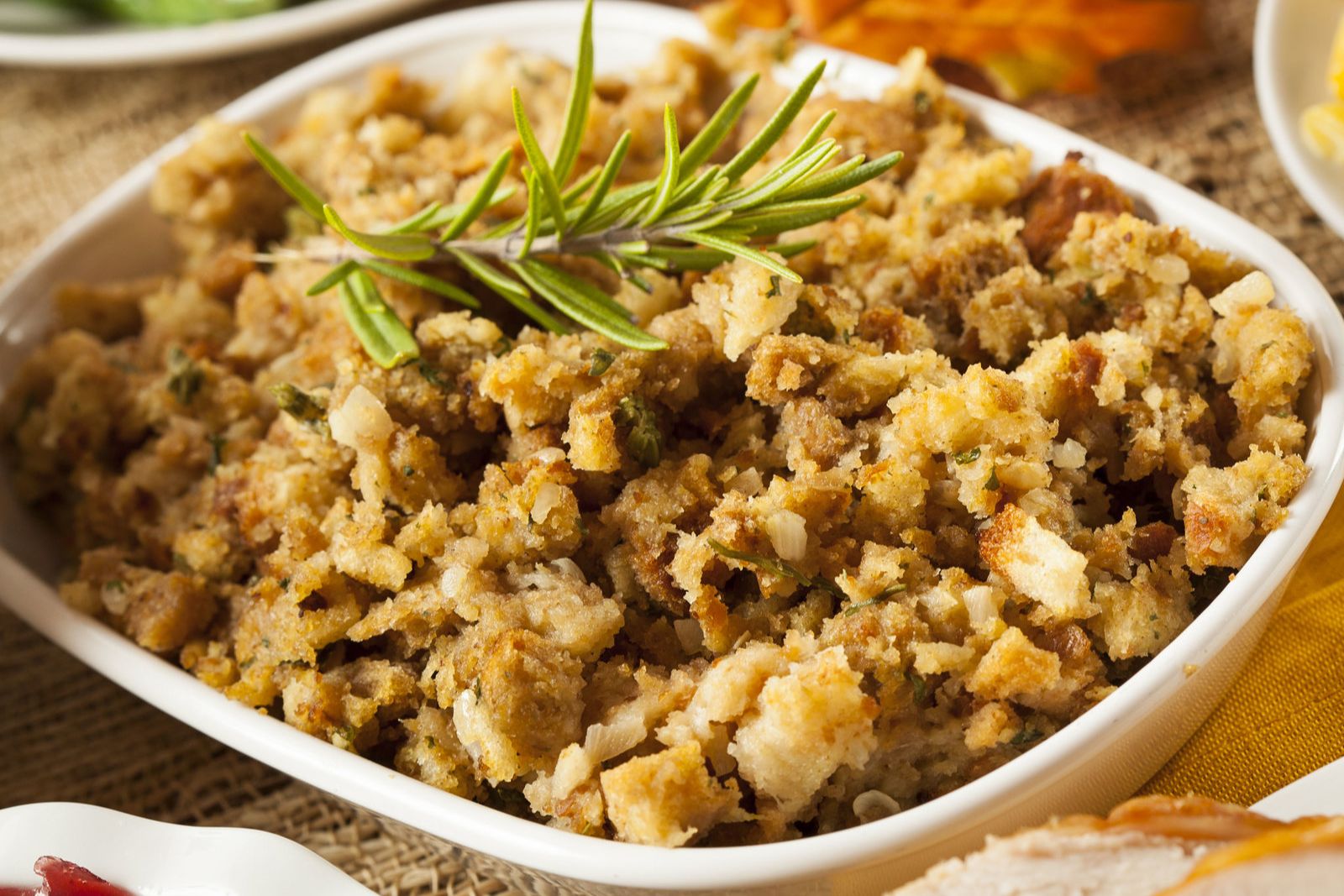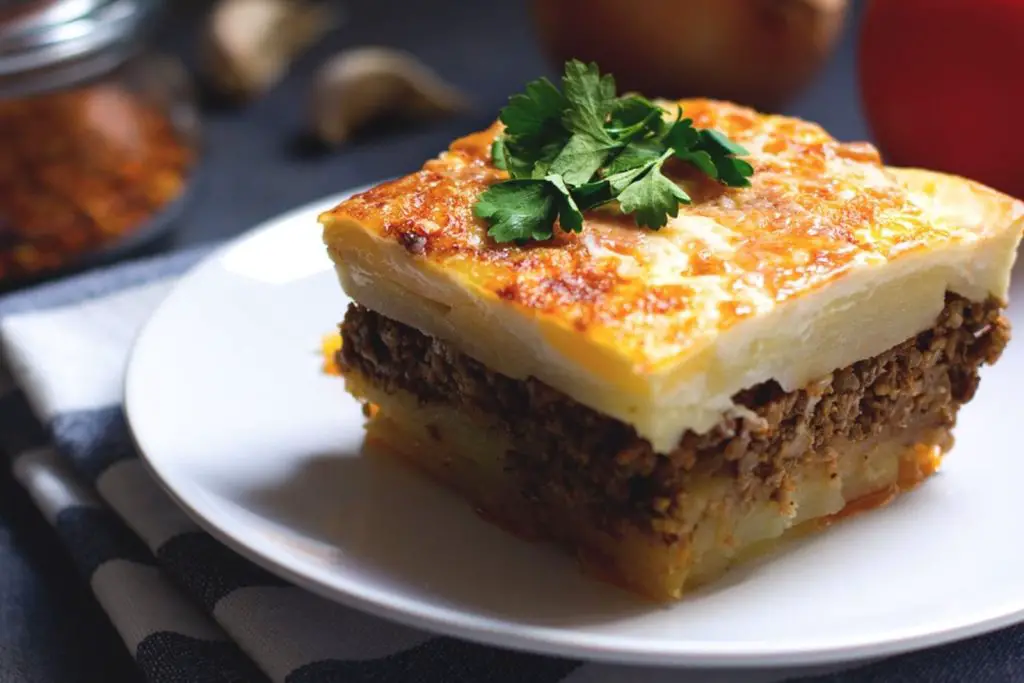
Bread stuffing, a beloved side dish that brings comfort and flavor to holiday feasts and special occasions. Bread stuffing, also known as dressing, is a delicious combination of cubed bread, savory seasonings, vegetables, and sometimes meat, all baked to perfection. Whether you prefer a traditional recipe with classic herbs or enjoy experimenting with unique flavor profiles, bread stuffing adds a delightful element to any meal. However, making a large batch of stuffing can sometimes result in leftovers. Freezing bread stuffing is a fantastic way to preserve its flavors and extend its shelf life, ensuring that you can enjoy this delectable dish long after the occasion has passed. In this guide, we’ll explore the process of freezing bread stuffing, offering helpful tips and techniques to maintain its texture and taste. So whether you’re planning ahead for future gatherings, want to have a convenient side dish ready to go, or simply can’t resist the flavors of bread stuffing all year round, freezing is a practical solution that allows you to enjoy this classic dish whenever you desire.
Here are the simple steps to freeze bread stuffing:
Step 1: Prepare the Bread Stuffing
The first step in freezing bread stuffing is to prepare the stuffing itself. Begin by following your preferred bread stuffing recipe. There are various types of bread you can use, such as white bread, cornbread, or even a mixture of different bread types for added flavor and texture.
To make the bread stuffing, you’ll typically need to tear or cube the bread into small pieces. The size of the pieces can vary depending on your preference—some people prefer larger chunks, while others prefer smaller, more evenly sized cubes.
Once you have the bread prepared, it’s time to cook and season the stuffing. Follow the instructions in your recipe, which may include sautéing vegetables like onions, celery, and carrots, along with herbs and spices such as sage, thyme, and parsley. The combination of ingredients and seasonings will add depth and flavor to the stuffing.
It’s essential to ensure that the stuffing is cooked thoroughly before freezing. This not only enhances the flavors but also helps prevent any potential foodborne illnesses. Cook the stuffing until the bread is moistened and has absorbed the flavors of the other ingredients.
By preparing the bread stuffing with care and attention to detail, you’ll create a delicious base that will freeze well and maintain its flavors when it’s time to reheat and enjoy the stuffing in the future.
Step 2: Cool the Stuffing
After you have prepared the bread stuffing, it is crucial to allow it to cool completely before moving on to the freezing process. Cooling the stuffing serves two main purposes: preventing condensation and ice crystal formation, and ensuring the optimal texture and taste of the stuffing when it is eventually reheated.
When hot or warm food is placed directly in the freezer, it releases moisture in the form of steam. This moisture can condense and form droplets on the surface of the stuffing, leading to the formation of ice crystals. These ice crystals can affect the texture of the stuffing, making it soggy or altering its consistency.
By allowing the stuffing to cool completely, you give the steam enough time to dissipate, minimizing the risk of condensation and ice crystal formation. Cooling also allows the flavors of the stuffing to settle and develop, resulting in a more well-rounded taste.
To cool the stuffing, transfer it to a shallow container or a wide, flat surface. This helps speed up the cooling process by allowing heat to escape more quickly. Avoid covering the stuffing while it cools, as covering it can trap heat and moisture, prolonging the cooling time.
The recommended cooling time can vary depending on the quantity and thickness of the stuffing. Generally, it is best to let the stuffing cool at room temperature for about 30 minutes to an hour. After this initial cooling period, you can move on to the next steps of the freezing process.
Taking the time to cool the stuffing thoroughly before freezing is essential to maintain its quality. It helps preserve the desired texture and prevents any unwanted changes that may occur due to condensation or ice crystal formation. With a properly cooled stuffing, you can be confident that it will retain its delicious taste and texture when it’s time to enjoy it later.
Step 3: Portion the Stuffing
Once your bread stuffing has cooled completely, it’s time to portion it into individual servings. This step allows for convenient storage and easy reheating of the desired amount of stuffing when needed. There are various methods and containers you can use to portion the stuffing, depending on your preference and available resources.
One option is to use muffin tins. Grease the muffin tin wells lightly and fill each well with a portion of the stuffing. This method creates individual, perfectly-sized portions that can be easily removed from the tin when frozen and stored in freezer bags or containers.
Alternatively, you can use baking dishes. Line the baking dish with parchment paper or aluminum foil for easier removal later on. Spread the cooled stuffing evenly in the dish and level it to your desired thickness. You can then cut the stuffing into individual squares or rectangles for portioning.
If you prefer a more flexible approach, simply scoop the cooled stuffing into freezer-safe containers or resealable bags. Make sure to leave some headspace to accommodate any potential expansion during freezing. Flatten the stuffing slightly in the container or bag to facilitate even freezing and easy stacking in the freezer.
When determining the portion sizes, consider your serving preferences or the number of people you intend to serve. Smaller portions are ideal for individual servings or for incorporating the stuffing into other recipes. Larger portions may be suitable for family-sized servings or if you prefer more substantial portions of stuffing.
By portioning the stuffing before freezing, you create convenient serving sizes and make it easier to thaw and reheat only the amount needed at a given time. This step adds practicality and versatility to the freezing process, ensuring that you can enjoy the bread stuffing in precisely the desired quantity whenever you desire.
Step 4: Wrap and Seal
After portioning the bread stuffing for freezing, it’s essential to wrap and seal the containers or individual portions properly. This step is crucial for preserving the quality and freshness of the stuffing, protecting it from freezer burn and maintaining its flavor and texture over time.
If you have used muffin tins or baking dishes to portion the stuffing, cover them tightly with plastic wrap or aluminum foil. The wrap or foil creates a barrier that helps prevent air and moisture from reaching the stuffing. Make sure the covering is secure and well-sealed around the edges to minimize any potential exposure to the freezer air.
For containers or resealable bags, it’s important to press out any excess air before sealing them shut. Excess air can contribute to freezer burn, which can negatively impact the taste and texture of the stuffing. By removing as much air as possible, you create a more protective environment for the stuffing.
When using resealable bags, a helpful technique is to partially seal the bag first, leaving a small opening. Then, gently press out the air before sealing the rest of the bag. This method helps remove air pockets effectively.
If using containers, ensure that the lids fit tightly and securely. This will prevent any air from entering the container and minimize the chances of freezer burn. If the container has a separate lid, double-check that it is properly sealed to maintain the optimal freshness of the stuffing.
Properly wrapping and sealing the bread stuffing is vital for its long-term storage. It helps protect the stuffing from freezer burn, which occurs when moisture evaporates from the surface of the food and is then replaced by dry freezer air. Freezer burn can result in a dry, discolored texture and an off-flavor.
By taking the time to wrap and seal the stuffed portions or containers, you ensure that the bread stuffing retains its quality and taste throughout its time in the freezer. This step is essential for preserving the flavors and textures you worked hard to achieve during the preparation process.
Step 5: Label and Date
Once you have wrapped and sealed the portions of bread stuffing for freezing, it’s important to label each portion with the contents and the date of freezing. This step serves two main purposes: easy identification and maintaining the optimal quality of the stuffing.
Using a permanent marker or labels, clearly write down what the portion contains, which in this case is bread stuffing. This will help you quickly identify the contents of each portion without having to unwrap or defrost them. It saves time and prevents any confusion when you’re looking for a specific item in your freezer.
In addition to labeling the contents, it’s crucial to include the date of freezing on each portion. Write down the month and day when you froze the bread stuffing. This is important because it allows you to keep track of the storage time and use the oldest portions first.
Freezing bread stuffing helps extend its shelf life, but it’s still best to consume it within a certain timeframe for optimal quality. By having the date of freezing clearly marked, you can easily determine which portions have been stored the longest and prioritize their use. This ensures that you rotate through the portions, using the oldest ones first to maintain the best taste and texture.
Labeling and dating the portions of bread stuffing are particularly helpful if you freeze multiple batches or varieties of stuffing. It allows you to differentiate between different recipes or types of stuffing, making it easier to choose the desired portion when you’re ready to enjoy it.
Taking the time to label and date the portions of bread stuffing might seem like a small step, but it significantly contributes to the organization and management of your frozen foods. It helps prevent waste, ensures you enjoy the stuffing at its peak quality, and simplifies the process of selecting and using the portions as needed.
Step 6: Place in the Freeze
Once you have properly labeled and dated the portions of bread stuffing, it’s time to transfer them to the freezer for freezing. Freezing preserves the freshness and quality of the stuffing, allowing you to enjoy it at a later time. Follow these steps to ensure proper freezing:
- Choose a flat surface: Select a flat surface in your freezer where you can place the wrapped or sealed portions of bread stuffing. This will help them freeze evenly and maintain their shape.
- Arrange the portions: Carefully place the wrapped or sealed portions of bread stuffing on the flat surface. Ensure they are not overcrowded, allowing enough space between each portion for air circulation.
- Avoid squishing: Take care not to stack or press the portions together tightly, as this can cause them to lose their shape or become compacted. It’s important to preserve the integrity and texture of the stuffing during freezing.
- Leave undisturbed: Once the portions are arranged in the freezer, avoid disturbing them for the initial freezing period. Leaving them undisturbed allows the temperature to drop evenly and promotes efficient freezing.
- Freezing time: The time required for the portions of bread stuffing to freeze completely can vary but is typically within the range of 2 to 4 hours. It’s important to note that the exact freezing time may depend on factors such as the thickness and size of the portions, as well as the efficiency of your freezer.
By allowing the bread stuffing portions to freeze evenly and retain their shape and texture. It’s essential to adhere to the freezing time to ensure proper preservation. Once the portions are completely frozen, they can be safely stored in the freezer for an extended period, ready to be reheated and enjoyed whenever desired.
Step 7: Transfer to Freezer Bags
If you have used muffin tins, baking dishes, or containers to freeze the portions of bread stuffing, you have the option to transfer them to freezer bags for easier storage and organization. This step is not necessary, but it can be beneficial, especially if you want to save space in your freezer or if you have limited container options available.
Transferring the frozen portions to freezer bags offers several advantages:
- Space-saving: Freezer bags are flexible and take up less space compared to rigid containers. By transferring the portions to freezer bags, you can stack and arrange them efficiently in your freezer, optimizing the available space.
- Easy storage: Freezer bags are lightweight and can be stored more easily than bulky containers. They can be tucked into small spaces or arranged in a way that suits your freezer layout, making it simpler to keep your frozen bread stuffing organized.
- Portion control: Freezer bags allow you to store individual portions separately, making it easier to retrieve and thaw only the amount of stuffing you need for a particular meal. This promotes portion control and reduces waste.
If you decide to transfer the portions to freezer bags, follow these steps:
- Ensure portions are fully frozen: Make sure the portions of bread stuffing are completely frozen before transferring them to freezer bags. This ensures that they hold their shape and do not stick together.
- Label the freezer bags: Before transferring the portions, label each freezer bag with the contents and the date of freezing. This labeling helps with easy identification later on.
- Place portions in freezer bags: Open a freezer bag and carefully place one portion of bread stuffing into the bag. Repeat this step for each portion, ensuring they are arranged in a single layer within the bag. Avoid overfilling the bag to prevent squishing or damaging the portions.
- Remove excess air and seal: Once the portions are in the freezer bag, press out any excess air to minimize the risk of freezer burn. Seal the bag securely, ensuring it is airtight.
- Stack and store: Place the sealed freezer bags of bread stuffing in your freezer, arranging them in a way that maximizes space and allows for easy access. Stack them neatly, keeping the labeled side facing outward for quick identification.
Transferring the frozen portions to freezer bags is an optional step that can provide convenience and space-saving benefits. It allows for better organization and makes it easier to retrieve and use the portions as needed while maintaining the quality of the bread stuffing throughout its storage in the freezer.
Step 8: Store in the Freezer
After you have transferred the portions of bread stuffing to freezer bags or containers, it’s time to return them to the freezer for long-term storage. Proper storage in the freezer helps maintain the quality and freshness of the bread stuffing. Follow these steps to ensure optimal storage:
- Dedicated freezer section: Choose a dedicated section in your freezer for storing the bread stuffing portions. This helps keep them organized and easily accessible when needed. It’s recommended to place them in a location where they won’t be frequently disturbed or exposed to temperature fluctuations.
- Arrange for easy retrieval: Stack or arrange the freezer bags or containers in a way that allows for easy retrieval. Consider labeling and arranging them based on the date of freezing, with the oldest portions at the front for prioritized use.
- Freezer temperature: Set your freezer to maintain a consistent temperature of 0°F (-18°C) or below. This temperature ensures the safe storage of the bread stuffing and helps preserve its quality over time.
- Storage duration: Bread stuffing can be stored in the freezer for up to 3 months. However, for the best quality, it is recommended to use it within 1 to 2 months. Over time, the quality of the stuffing may gradually decline, so consuming it within this timeframe ensures optimal taste and texture.
- Avoid freezer door openings: Minimize the number of times you open the freezer door to maintain a stable temperature. Frequent door openings can lead to temperature fluctuations, affecting the quality of the stored bread stuffing.
By maximizing the shelf life of the bread stuffing while preserving its taste and texture. Proper storage conditions and a well-organized freezer section contribute to an efficient and enjoyable frozen food experience.
Other related questions
How do you defrost bread stuffing?
To defrost bread stuffing, it is recommended to transfer the frozen portions from the freezer to the refrigerator. Allow the bread stuffing to thaw slowly in the refrigerator overnight or for several hours until it is completely thawed. Alternatively, you can reheat the frozen bread stuffing directly in the oven or microwave, following the specific instructions for your recipe or package.
Can you refreeze bread stuffing?
It is generally not recommended to refreeze bread stuffing once it has been thawed. Refreezing can negatively impact the texture and quality of the stuffing, leading to potential changes in taste and moisture content. To maintain the best taste and texture, it is advisable to thaw and use the bread stuffing in its entirety, ensuring proper storage and consumption.
How do I know if the bread stuffing has gone bad after being frozen?
To determine if bread stuffing has gone bad after being frozen, there are a few signs to look out for. These include a noticeable change in texture, such as excessive dryness or sogginess, as well as an off or unpleasant odor. Additionally, if there are any signs of mold or unusual discoloration, it is best to discard the bread stuffing to ensure food safety.
Can I freeze bread stuffing with gravy?
Yes, you can freeze bread stuffing with gravy, but it is recommended to freeze them separately for better results. Freezing them together may affect the texture and quality of both the bread stuffing and the gravy. To freeze, portion the bread stuffing and gravy into separate freezer-safe containers or bags, ensuring they are tightly sealed, labeled, and dated before placing them in the freezer.
Is it better to freeze stuffing cooked or uncooked?
It is generally better to freeze stuffing uncooked rather than cooked. Freezing uncooked stuffing helps maintain its texture and flavor during the freezing and reheating process. Cooked stuffing can become mushy and lose its desirable texture when frozen and thawed. However, it is important to follow proper food safety guidelines and ensure thorough cooking when reheating frozen uncooked stuffing before consumption.








